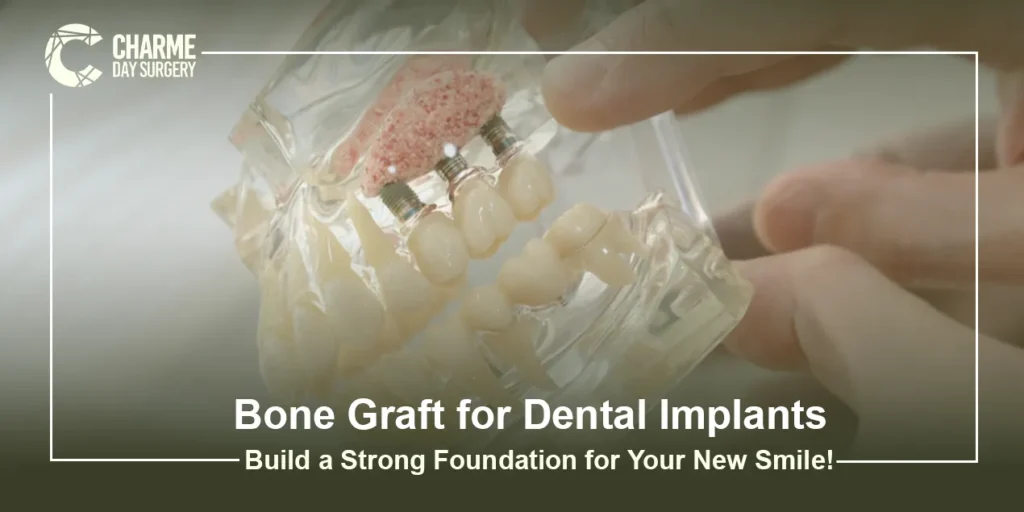The Bone Graft for Dental Implants is like building your dream villa on a solid foundation. Just as strong concrete supports a lasting home, a healthy, dense jawbone is essential for implant success.
When that foundation is weak, bone grafting rebuilds it, turning what was once a complex procedure into a routine, reliable step that helps nearly anyone enjoy the life-changing benefits of dental implants.
What is a Bone Graft for Dental Implants? Rebuilding Jawbone for Implant Success
At its core, a Bone Graft for Dental Implants is a procedure designed to add volume and density to your jawbone in an area where teeth are missing. Think of it like enriching the soil in a garden before planting a precious tree.
You want to give the roots the best possible environment to grip, grow, and thrive. Similarly, this procedure places special bone grafting material in the deficient area, which then acts as a scaffold or a signal, encouraging your own body to grow new, natural bone tissue around it.
Over time, your body replaces the graft material with your own healthy bone, creating that solid, reliable foundation we need for a successful dental bone graft procedure in Dubai and subsequent implant placement.
Why Might You Need a Bone Graft Before Dental Implants?
The need for bone augmentation is common and arises from several natural processes. Here are the primary reasons why this preparatory step might be essential for you:
Insufficient Bone Density or Volume
Just as some people are naturally taller or shorter, some are born with naturally thinner or less dense jawbones. Attempting to place an implant in a thin ridge of bone is like trying to secure a heavy-duty screw into a thin piece of plasterboard; it simply won’t hold securely.
A Bone Graft for Dental Implants is the solution that adds the necessary thickness and strength.
Bone Loss Due to Tooth Extraction or Gum Disease
Your jawbone has a “use it or lose it” relationship with your teeth. The roots of your teeth constantly stimulate the surrounding bone, keeping it strong and healthy. The moment a tooth is lost, that stimulation vanishes.
The body, being incredibly efficient, begins to resorb or shrink the bone in that area because it no longer serves a purpose. Gum disease can also actively destroy the bone that supports the teeth. This is where Bone augmentation dental implants Dubai become crucial to reverse that loss.
Preparing for Successful Implant Integration
The magic of a dental implant lies in a process called osseointegration, where the titanium implant fuses directly with the living bone. For this incredible fusion to occur, the implant must be completely enveloped by a sufficient amount of healthy bone.
A Bone Graft for Dental Implants ensures there is more than enough bone to create this powerful, lasting bond.
The Bone Grafting Procedure in Dubai: What to Expect
The idea of a Bone grafting procedure Dubai can sound intimidating, but the reality is often a simple and comfortable in-office experience. The process generally involves making a small incision in the gum to expose the underlying bone, placing the grafting material where it’s needed, and then securing the area with a special membrane before closing the gum tissue.
The procedure is performed with local anesthesia, ensuring you feel no pain.
Types of Bone Grafts for Dental Implants Performed at Charme Medical
Just as there are different materials to build a foundation, there are various sources for bone grafting material. We select the best one based on your specific needs. The main Types of dental bone grafts Dubai include:
Autogenous Bone Grafts (from your own body):
This is considered the “gold standard.” A small amount of bone is taken from another area of your body (like your chin or hip) and moved to your jaw. Because it’s your own tissue, it contains living cells that promote rapid and excellent new bone growth.
Allograft (human donor bone):
This is bone sourced from a human tissue bank. It undergoes a rigorous sterilization and processing procedure to ensure it is completely safe and free of any cells, acting as a sterile framework for your body to build upon.
Xenograft (animal bone):
Typically sourced from bovine (cow) bone, this material is also highly sterilized and processed. The mineral structure is very similar to human bone and acts as an excellent, slow-resorbing scaffold, giving your body plenty of time to build new bone.
Alloplast (synthetic materials):
These are man-made, biocompatible materials (often a form of calcium phosphate) that act as a framework. They are designed to be safely absorbed and replaced by your body’s own natural bone over time.
To learn how our comprehensive dentistry services can support your journey, explore our offerings here.
Bone Graft for Dental Implants Cost in Dubai: Factors Influencing Price
When considering the Bone graft for implants cost Dubai, it’s best to view it as an integral part of the overall investment in a successful, long-term dental implant. The final cost is not a single number but depends on several factors:
- The type and amount of graft material required.
- The complexity of the procedure and the size of the area being treated.
- Whether any special membranes or technologies are used to enhance the outcome.
During your consultation, we provide a clear and transparent breakdown of all costs associated with your personalized treatment plan for a Bone Graft for Dental Implants.
Recovery and Healing Time After a Dental Bone Graft
Patience is a key ingredient for success. After the procedure, the grafting material needs time to integrate and mature into strong, solid bone. Think of it like waiting for concrete to fully cure before you can build on it.
The typical Bone graft recovery time Dubai before an implant can be placed is anywhere from 4 to 9 months. During this period, you will have follow-up visits to monitor your healing progress, ensuring everything is developing perfectly for your future implant.
Why Trust Charme Medical for Your Bone Grafting Needs in Dubai?
Choosing where to have your Bone Graft for Dental Implants is as important as the procedure itself. At Charme Medical, we don’t guess, we measure. We utilize state-of-the-art 3D CBCT imaging to precisely analyze your bone structure and plan the graft with surgical accuracy.
Our experienced team is skilled in the latest minimally invasive techniques to ensure your comfort and promote faster, more predictable healing. We understand the trust you place in us to build the foundation for your new smile, and we honor that trust with expertise and compassion.
Conclusion: Ensuring a Solid Base for Your New Smile
A successful dental implant is a partnership between advanced technology and your body’s natural healing abilities. A bone graft for Dental Implants is often the critical first step that empowers this collaboration.
It is the careful, foundational work that ensures your new tooth will be as strong, stable, and reliable as a natural one, allowing you to smile, speak, and eat with complete confidence for years to come.
FAQ
Is a dental bone graft painful?
No. Bone graft for dental implants is performed under local anesthesia, so you won’t feel pain during the procedure. Any post-treatment discomfort is usually mild and manageable with over-the-counter pain medication. Most patients find it even less uncomfortable than a simple tooth extraction.
How long does it take for a bone graft to heal before implant placement?
Healing typically takes 4 to 9 months, depending on the type and amount of grafting material used. This time allows the graft to integrate and form strong, healthy bone, creating the ideal foundation for a long-lasting dental implant.
Are there alternatives to bone grafting for dental implants?
In some cases, yes. Options like using shorter implants, angling implants to engage existing bone (as in the All-on-4 technique), or using narrow-diameter mini-implants can sometimes bypass the need for grafting.
What are the risks associated with dental bone grafting?
Like any surgical procedure, there are minor risks such as infection, bleeding, or graft failure. However, these risks are very low, especially when performed by an experienced specialist and when post-operative instructions are followed carefully.


